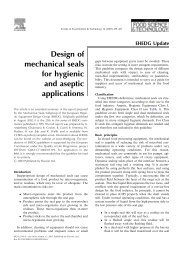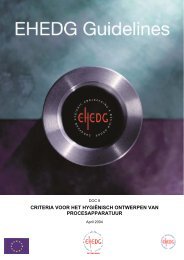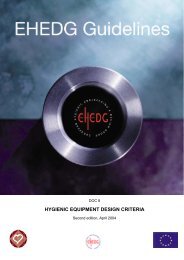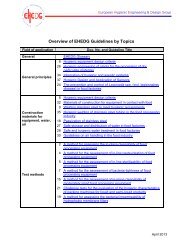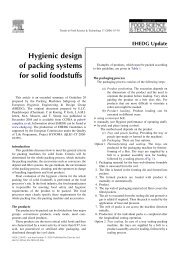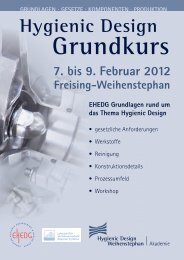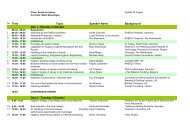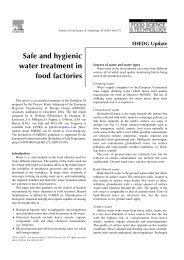Yearbook 2013/2014 - ehedg
Yearbook 2013/2014 - ehedg
Yearbook 2013/2014 - ehedg
You also want an ePaper? Increase the reach of your titles
YUMPU automatically turns print PDFs into web optimized ePapers that Google loves.
18 Legal requirements for hygienic design in Europe<br />
EU Regulation 1935/2004 on materials and articles<br />
intended to come into contact with food covers the following<br />
equipment: processing machinery and filling equipment, and<br />
kitchen equipment, containers, and packaging materials. The<br />
regulation specifically requires that food-contact materials<br />
and equipment comply with the following:<br />
• No human health hazards<br />
• No indefensible modification of food composition<br />
• No detraction from organoleptic food properties<br />
• No misdirection of customers<br />
• Use of ‘for food contact’ or the symbol (Figure 2). (This<br />
symbol is only needed, if there is no instruction manual<br />
and if it is not obvious that this is for food contact).<br />
• Traceability on all manufacturing and distribution steps<br />
EU Regulation 2023/2006 of 22 December 2006 on good manufacturing<br />
practice (GMP) for materials and articles intended to come<br />
into contact with food requires that the following must be set up and<br />
installed for all producers of materials intended to come into contact<br />
with food and are covered by EU Regulation 1935/2004:<br />
• Quality assurance system<br />
• Quality control system<br />
• Documentation<br />
According to Article 2 of EC 2023/2006: “This regulation shall<br />
apply to all sectors and all stages of manufacture, processing<br />
and distribution of materials and articles, up to but excluding<br />
the production of starting substances.” This means that,<br />
for example, all producers of plastic materials must have a<br />
quality system that includes the required documentation if<br />
they produce materials intended to come in food contact.<br />
Depending on the risk assessment, this documentation must<br />
be more or less detailed, corresponding to the known or<br />
potential risk.<br />
To prevent consumers from absorbing toxic substances<br />
that may leach from plastics that come into contact with<br />
foods, the European Commission has issued EU Regulation<br />
10/2011 on plastic materials and articles intended to come<br />
into contact with food. Rubber and silicone materials are not<br />
covered by this regulation. Since there is nothing specific<br />
for seals in Europe, the US Food and Drug Administration<br />
(FDA) Code of Federal Regulations (CFR) 21 is commonly<br />
used in Europe.<br />
Food safety is the core interest of the European Commission.<br />
EC Directive 2006/42/EC, or the Machinery Directive, which<br />
came into force at the end of 2009, sets up the essential<br />
requirements for machinery. All machines brought to the<br />
European market must fulfil these requirements. The CE<br />
mark, which identifies industrial equipment as in compliance<br />
with all the of safety requirements established by the<br />
European Union must appear on each unit (Figure 1).<br />
Annex I of the Machinery Directive describes in detail what<br />
has to be taken into consideration to build safe machines.<br />
Of particular interest to the food industry is Chapter 2.1 of<br />
Annex I, entitled ‘Foodstuffs machinery and machinery for<br />
cosmetics or pharmaceutical products.’ This chapter not only<br />
takes into consideration potentially hazardous situations<br />
for equipment operators and the environment in which the<br />
machine is used, but it is the only chapter in this directive<br />
that refers to the potential hazards for the consumer of the<br />
product produced on these machines. Essentially, this means<br />
that mistakes caused by neglecting these requirements can<br />
have a strong impact on public health.<br />
The Machinery Directive states that all surfaces (with the exception<br />
of disposable parts), including joining areas that come into product<br />
contact must:<br />
• Be smooth, without ridges or crevices<br />
• Reduce projections, edges and recesses to a minimum<br />
• Be easily cleaned and disinfected<br />
• Inside surfaces must have curves of a radius sufficient<br />
to allow sufficient cleaning<br />
From a hygienic design perspective, the following re quirements<br />
are particularly noteworthy:<br />
• It must be possible for liquids, gases and aerosols<br />
deriving from products and from cleaning, disinfecting<br />
and rinsing fluids to be completely discharged from the<br />
machinery.<br />
• Machinery must be designed and constructed in such<br />
a way as to prevent any substances or living creatures,<br />
in particular insects, from entering, or any organic<br />
matter from accumulating.<br />
• Machinery must be designed and constructed in such<br />
a way that no ancillary substances that are hazardous<br />
to health, including the lubricants used, can come into<br />
contact with products.<br />
Figure 2. EU food contact symbol used for marking materials<br />
intended to come into contact with food in the European Union as<br />
defined in EU Regulation 1935/2004.<br />
For food processing machines, so-called “C-Standards”<br />
also are provided in some detail, including how the design<br />
of the machine (e.g., the roughness of the surfaces)<br />
should be addressed in machines used in contact with<br />
specific products. The standards EN ISO 14159, “Safety<br />
of machinery - Hygiene requirements for the design of<br />
machinery” and EN 1672-2, “Food processing machinery -<br />
Basic concepts - Part 2: Hygiene requirements” describe the<br />
aim of the Directive through examples.<br />
In addition to these standards, the European Hygienic<br />
Engineering & Design Group (EHEDG) Guideline 8 criteria<br />
and the EHEDG Guideline 13, Hygienic design of equipment<br />
for open processing, offer additional guidance. The content



